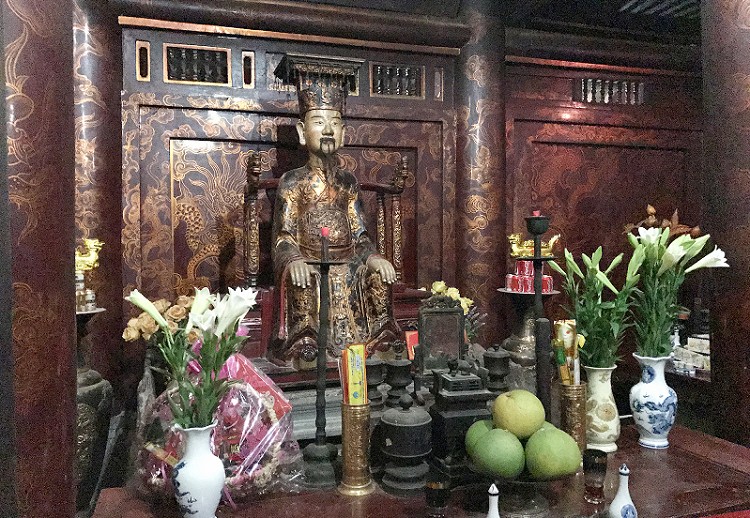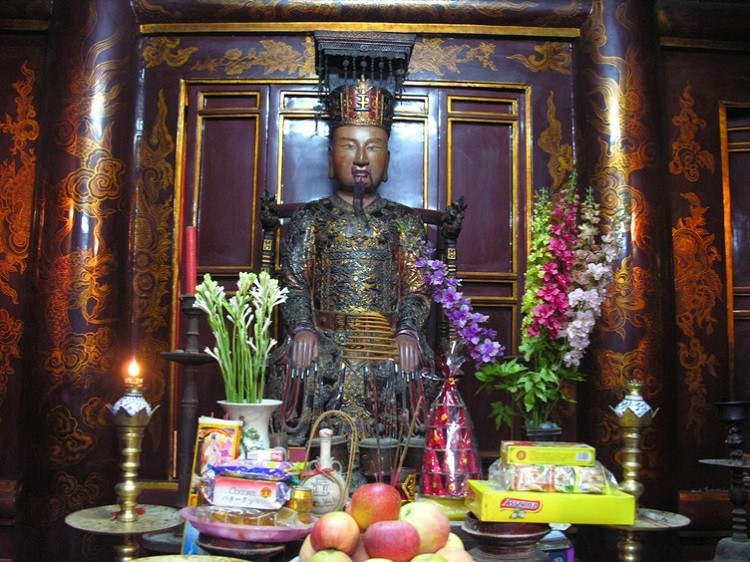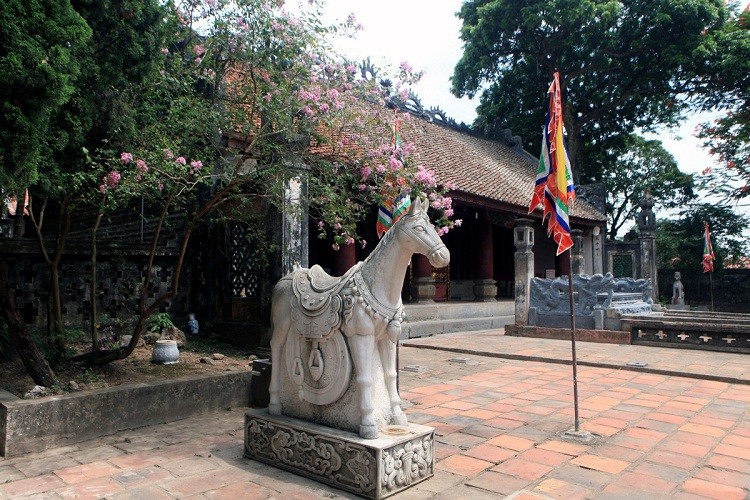Are you planning a historical and cultural journey to Vietnam and wondering about the key historical sites? What are the main temples remaining at Hoa Lu? The Dinh King Temple and Le King Temple stand as iconic landmarks representing Vietnam’s rich heritage. Let SIXT.VN be your trusted companion, providing seamless travel solutions and insider tips to enrich your exploration of Vietnam’s ancient capital. Discover the majestic architecture, profound history, and cultural significance of these revered temples with our expert guidance.
1. What is the Historical Significance of Hoa Lu Ancient Capital?
Hoa Lu Ancient Capital holds immense historical significance as the first capital of Vietnam, marking the establishment of a centralized feudal state. This period represents a pivotal chapter in Vietnamese history, witnessing the rise of the Dinh and Le dynasties.
- Foundation of Dai Co Viet: In 968, Dinh Bo Linh unified the country and established the Dai Co Viet kingdom, choosing Hoa Lu as its capital, which marked the beginning of centralized feudal rule in Vietnam.
- Location and Landscape: Nestled amidst the stunning landscapes of Ninh Binh, Hoa Lu’s serene and majestic setting reflects its historical importance. The ancient city is surrounded by limestone karsts and lush greenery, creating a picturesque backdrop.
- Dynastic Era: Hoa Lu served as the capital under the Dinh dynasty (968-980), the Early Le dynasty (980-1009), and the early Ly dynasty (1009-1010) before the capital was moved to Thang Long (Hanoi).
- Key Achievements: The era saw significant milestones, including the country’s unification, resistance against the Song dynasty, suppression of the Chams, and the eventual transfer of the capital to Thang Long (Hanoi), setting the stage for future dynasties. According to the “Historical Records of Dai Viet” in 1010, King Ly Thai To decided to move the capital from Hoa Lu to Thang Long because he saw that Thang Long was in a more advantageous geographical position, a more developed and prosperous area, and more suitable for the long-term development of the country.
- Enduring Legacy: Despite the passage of over 1,000 years, many remnants of Hoa Lu’s ancient capital are still preserved and respected, underscoring its enduring historical legacy.
- UNESCO Recognition: In 2014, UNESCO recognized Hoa Lu as a mixed cultural and natural heritage site, highlighting its global importance.
2. What are the Key Structures within the Dinh King Temple Complex?
The Dinh King Temple complex features several key structures showcasing unique Vietnamese architectural styles and historical significance. It exemplifies the architectural style of “solid interior, ornate exterior,” a hallmark of Vietnamese craftsmanship from the 17th to 19th centuries.
- Ngo Mon Quan (Main Gate): The main entrance to the temple complex, Ngo Mon Quan, features three covered sections adorned with intricate tile work. This serves as the primary access point, welcoming visitors into the historical site.
- Nghi Mon (Inner Gate): After passing through the courtyard, visitors encounter the Nghi Mon, an inner gate constructed from sturdy lim wood. It features three rows of columns and is fortified with large pillars at each corner, adding to its imposing structure.
- Dragon Courtyard: The dragon courtyard serves as an open space leading to the prayer hall, providing a transition between the outer and inner sections of the temple.
- Prayer Hall: Ascending from the dragon courtyard, visitors reach the five-bay prayer hall, which showcases distinctive architectural designs. This hall is used for preparatory rites and ceremonies.
- Incense Offering Space: The space dedicated to incense offerings is dedicated to the four pillars of the Dinh dynasty. It connects the prayer hall to the main sanctuary, serving as a place for veneration.
- Main Sanctuary: At the far end of the complex is the main sanctuary, a five-bay structure that houses a bronze statue of King Dinh resting on a green stone base. The statue serves as the central point of reverence within the temple.
- Stone Dragons: Flanking the statue of King Dinh are two stone dragons carved in the style of saddle stirrups. These dragons symbolize power and protection.
- Artificial Mound, Lotus Pond, and Flower Gardens: Enhancing the aesthetic appeal of the temple complex are an artificial mound, a lotus pond, and flower gardens. These elements contribute to the serene and picturesque setting.
 Statue of King Dinh
Statue of King Dinh
3. What is the Architectural Style of the Dinh King Temple?
The architectural style of the Dinh King Temple is characterized by its “solid interior, ornate exterior” design, showcasing remarkable Vietnamese craftsmanship and artistic elements. The temple was built during the Ly dynasty and later restored by the Later Le dynasty in the 17th century.
- Solid Interior, Ornate Exterior: The Dinh King Temple is known for its “solid interior, ornate exterior” architectural style. This design approach prioritizes a robust and enduring structure while emphasizing intricate and decorative external features.
- Wood and Stone Carvings: The temple features remarkable examples of wood and stone carving art, created by Vietnamese artisans from the 17th to the 19th centuries. These carvings depict historical scenes, mythical creatures, and ornamental patterns.
- Majestic Structures: The temple complex includes several majestic structures such as the Ngo Mon Quan (main gate), an artificial mound, a lotus pond, flower gardens, both interior and exterior entrances, three prayer halls, a space for incense offerings, and a main sanctuary.
- Three-Section Design: Like many traditional Vietnamese temples, the Dinh King Temple follows a three-section layout: the prayer hall, the space for incense offerings, and the main sanctuary. Each section serves a specific purpose in religious ceremonies.
4. What are the Unique Features of the Le King Temple?
The Le King Temple, dedicated to King Le Dai Hanh, shares architectural similarities with the Dinh King Temple but possesses unique features that distinguish it. It reflects the architectural style prevalent in the 17th century.
- Location and Proximity: Situated approximately 500 meters north of the Temple of King Dinh, the Le King Temple is easily accessible, allowing visitors to explore both historical sites in a single visit.
- Dedication: The Le King Temple honors King Le Dai Hanh and his mother, Duong Van Nga, recognizing their contributions to Vietnamese history.
- Architectural Style: The temple preserves the unique artistic architecture of the 17th century, featuring a similar “solid interior, ornate exterior” style seen in the Dinh King Temple.
- Three Sections: The temple includes three sections: the prayer hall, the space for incense offerings, and the main sanctuary.
- Recessed Door: The temple’s door is recessed to the large columns, surrounded by walls, creating a relatively dark interior space. This design element adds to the sense of mystery and reverence within the temple.
- Dim Lighting: The dim light that enters the temple gives the offerings and statues an aura of majesty, antiquity, and mystery, enhancing the spiritual atmosphere.
 Statue of King Le
Statue of King Le
5. How do the Temples of Dinh and Le Kings Reflect Vietnamese Culture and History?
The temples of the Dinh and Le Kings serve as profound reflections of Vietnamese culture and history, symbolizing respect, gratitude, and the enduring legacy of the Hoa Lu dynasty. These temples remind us of the glorious era and the independence of the state of Dai Co Viet. It was during this period that the Vietnamese people successfully established a centralized feudal state with its own government and military.
- Symbols of Respect and Gratitude: The temples embody the Vietnamese people’s respect and gratitude towards Kings Dinh and Le, who played crucial roles in building and protecting the country in the 10th century.
- Relics of the Hoa Lu Dynasty: The temples stand as relics of the Hoa Lu dynasty’s historic capital, reminding visitors of the nation’s formative years.
- Glorious Era: They evoke memories of a glorious era and the independence of the state of Dai Co Viet, highlighting the establishment of a centralized feudal state with its own government and military.
- Cultural and Historical Values: The temples serve as places for the preservation and promotion of Vietnamese cultural and historical values, affirming the existence and development of a unique and rich culture.
- UNESCO Recognition: Hoa Lu’s recognition by UNESCO underscores the global significance of these cultural and historical sites, attracting tourists and scholars alike.
6. What is the Best Time to Visit the Temples of Dinh and Le Kings?
The best time to visit the Temples of Dinh and Le Kings is during the dry season, from November to April, when the weather is favorable for outdoor exploration.
- Dry Season (November to April): The dry season offers pleasant weather conditions, with lower humidity and less rainfall, making it ideal for touring historical sites and enjoying outdoor activities.
- Shoulder Seasons (March-May & September-November): The shoulder seasons provide a balance of good weather and fewer crowds compared to the peak tourist season.
- Avoid the Rainy Season (May to October): The rainy season can bring heavy rainfall and potential flooding, which may disrupt travel plans and limit outdoor activities.
- Hoa Lu Festival: Consider visiting during the Hoa Lu Festival (usually in April) to witness traditional ceremonies, cultural performances, and local festivities. According to the Hoa Lu Ancient Capital Management Board, the Hoa Lu Festival is held annually from the 6th to the 8th days of the 3rd lunar month to commemorate the merits of King Dinh Tien Hoang and King Le Dai Hanh.
- Weekday Visits: To avoid large crowds, plan your visit on weekdays rather than weekends or public holidays.
- Morning or Late Afternoon: Visit the temples in the early morning or late afternoon to avoid the midday heat and enjoy a more peaceful experience.
7. What are the Travel Options to Reach the Temples from Hanoi?
Reaching the Temples of Dinh and Le Kings from Hanoi is convenient with several travel options available to suit different preferences and budgets.
- Private Car: Hiring a private car with a driver is the most comfortable and convenient option. SIXT.VN offers reliable and affordable private car services, ensuring a smooth and hassle-free journey from Hanoi to Ninh Binh.
- Train: Taking a train from Hanoi to Ninh Binh is a scenic and cost-effective option. Trains depart regularly from Hanoi Railway Station and take approximately 2 to 2.5 hours to reach Ninh Binh.
- Bus: Several bus companies operate daily services from Hanoi to Ninh Binh. Buses are a budget-friendly option, but the journey may be longer due to multiple stops.
- Motorbike: Adventurous travelers can opt to rent a motorbike and drive to Ninh Binh. The journey takes around 2 to 3 hours, offering flexibility to explore the countryside along the way.
- SIXT.VN Services: SIXT.VN provides comprehensive travel solutions, including airport transfers, car rentals, and tour packages, making your trip to Ninh Binh seamless and enjoyable.
- Airport Transfers: Arrange a private airport transfer with SIXT.VN for a comfortable and stress-free journey from Hanoi Airport to Ninh Binh.
- Car Rentals: Rent a car from SIXT.VN and enjoy the freedom to explore Ninh Binh and its surrounding areas at your own pace.
- Tour Packages: Opt for a guided tour package from SIXT.VN, which includes transportation, accommodation, and visits to the Temples of Dinh and Le Kings, as well as other attractions in Ninh Binh.
8. What Other Attractions Can Be Combined with a Visit to Hoa Lu?
Combining a visit to Hoa Lu with other attractions in Ninh Binh can enhance your travel experience, allowing you to explore the region’s natural beauty and cultural heritage.
- Trang An Landscape Complex: A UNESCO World Heritage site, Trang An features stunning limestone karsts, serene rivers, and mysterious caves. Take a boat tour to explore the interconnected waterways and grottoes. According to UNESCO, Trang An is recognized for its outstanding natural beauty and geological significance, featuring a blend of cultural and natural values.
- Tam Coc-Bich Dong: Known as “Halong Bay on Land,” Tam Coc offers boat rides through picturesque rice paddies and caves. Bich Dong Pagoda, nestled in a mountainside, is also worth visiting.
- Bai Dinh Pagoda: One of Southeast Asia’s largest pagoda complexes, Bai Dinh boasts impressive architecture, intricate statues, and serene landscapes.
- Mua Cave: Climb to the top of Mua Cave for panoramic views of Tam Coc’s stunning landscape and the surrounding countryside. The viewpoint offers incredible photo opportunities.
- Phat Diem Stone Cathedral: A unique blend of Vietnamese and European architectural styles, Phat Diem Cathedral is a remarkable religious site constructed primarily of stone.
- Van Long Nature Reserve: A tranquil wetland area, Van Long is home to diverse bird species and the rare Delacour’s langur. Take a boat trip to observe the wildlife and enjoy the peaceful scenery.
- Thung Nham Bird Park: A haven for birdwatchers, Thung Nham is home to numerous bird species, including storks, herons, and egrets. Explore the park by boat or on foot.
9. What are the Accommodation Options Near Hoa Lu?
Various accommodation options are available near Hoa Lu, ranging from budget-friendly guesthouses to luxurious resorts, catering to different preferences and budgets.
- Tam Coc Area: Many hotels, resorts, and guesthouses are located in the Tam Coc area, offering easy access to Hoa Lu and other nearby attractions.
- Ninh Binh City: Ninh Binh City provides a wider range of accommodation options, including international hotels, local guesthouses, and serviced apartments.
- Homestays: For a more immersive cultural experience, consider staying in a homestay in the surrounding villages, where you can interact with local families and learn about their way of life.
- Luxury Resorts: Several luxury resorts are located in the Ninh Binh region, offering top-notch amenities, spa services, and stunning views of the natural landscape.
- Budget Guesthouses: Budget travelers can find affordable guesthouses and hostels in Ninh Binh City and Tam Coc, providing basic amenities and convenient locations.
- SIXT.VN Hotel Booking: SIXT.VN offers a comprehensive hotel booking service, allowing you to find and book the perfect accommodation for your trip to Ninh Binh.
10. What are the Benefits of Using SIXT.VN for Planning Your Trip to Hoa Lu?
Using SIXT.VN for planning your trip to Hoa Lu offers numerous benefits, ensuring a seamless, convenient, and enjoyable travel experience.
- Comprehensive Travel Solutions: SIXT.VN provides a wide range of travel services, including airport transfers, car rentals, hotel bookings, and tour packages, catering to all your travel needs in one place.
- Reliable and Affordable Services: SIXT.VN offers reliable and affordable services, ensuring you get the best value for your money.
- Convenience: With SIXT.VN, you can book all your travel arrangements online, saving time and effort.
- Customized Travel Plans: SIXT.VN can help you create customized travel plans tailored to your interests and preferences, ensuring you get the most out of your trip to Ninh Binh.
- Local Expertise: SIXT.VN has extensive local knowledge and can provide insider tips and recommendations to enhance your travel experience.
- 24/7 Customer Support: SIXT.VN offers 24/7 customer support, ensuring assistance is always available whenever you need it.
- Seamless Experience: From airport pickup to hotel check-in and guided tours, SIXT.VN ensures a seamless and stress-free travel experience.
Ready to explore the historical wonders of Hoa Lu? Let SIXT.VN take care of all your travel needs. Contact us today to book your airport transfer, car rental, hotel, or guided tour, and embark on an unforgettable journey through Vietnam’s ancient capital.
Address: 260 Cau Giay, Hanoi, Vietnam
Hotline/Whatsapp: +84 986 244 358
Website: SIXT.VN
 King Dinh Temple, Ninh Binh
King Dinh Temple, Ninh Binh
FAQ about Hoa Lu Temples
1. Why is Hoa Lu historically significant?
Hoa Lu holds immense historical significance as the first capital of Vietnam, marking the establishment of a centralized feudal state.
2. What dynasties ruled from Hoa Lu?
Hoa Lu served as the capital under the Dinh dynasty (968-980), the Early Le dynasty (980-1009), and the early Ly dynasty (1009-1010).
3. What is the architectural style of Dinh King Temple?
The Dinh King Temple features a “solid interior, ornate exterior” design, showcasing remarkable Vietnamese craftsmanship and artistic elements.
4. What is the main deity worshipped in the Le King Temple?
The Le King Temple honors King Le Dai Hanh and his mother, Duong Van Nga, recognizing their contributions to Vietnamese history.
5. What is the best time to visit Hoa Lu?
The best time to visit Hoa Lu is during the dry season, from November to April, when the weather is favorable for outdoor exploration.
6. How can I travel from Hanoi to Hoa Lu?
You can travel from Hanoi to Hoa Lu by private car, train, bus, or motorbike. SIXT.VN offers reliable and affordable private car services.
7. What other attractions can I visit near Hoa Lu?
Other attractions near Hoa Lu include Trang An Landscape Complex, Tam Coc-Bich Dong, Bai Dinh Pagoda, and Mua Cave.
8. What types of accommodations are available near Hoa Lu?
Various accommodation options are available near Hoa Lu, ranging from budget-friendly guesthouses to luxurious resorts.
9. Why should I use SIXT.VN for planning my trip to Hoa Lu?
SIXT.VN offers comprehensive travel solutions, reliable services, local expertise, and 24/7 customer support for a seamless travel experience.
10. What is the Hoa Lu Festival?
The Hoa Lu Festival is an annual event held to commemorate the merits of King Dinh Tien Hoang and King Le Dai Hanh, featuring traditional ceremonies and cultural performances.



